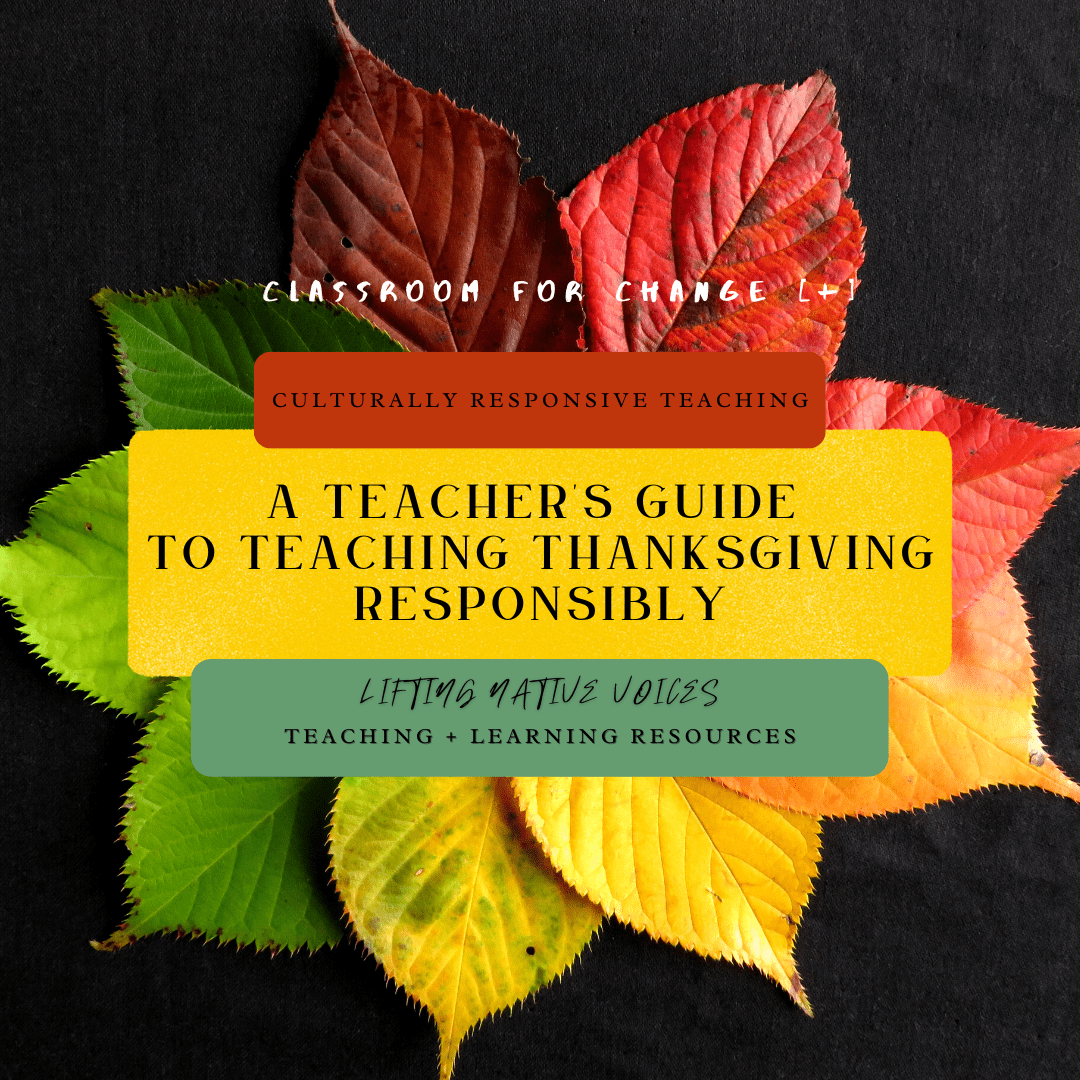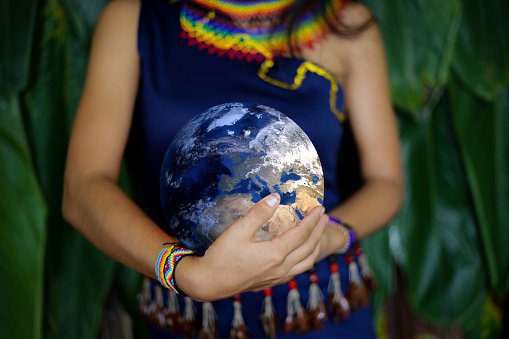Browse around
topics
Hey changemaker!
proud mama, fearless educator, forever learner + founder of Classroom For Change.
I'm Rose Cherussery
As an elementary + middle school teacher turned teacher educator now Ph.D. student, I have dedicated my life to teaching + empowering kids and adults to be change agents for good. I created Classroom For Change as a way to bring about positive change to the classroom + beyond. I'm so glad you're here. Here's to the change I know we'll be together! Read my story
Soundtrack for Change
Music that moves, motivates + inspires change
A Teacher’s Guide to Teaching Thanksgiving Responsibly

Posted In
November 25, 2020
Posted On
This blog post was originally published on November 25, 2020 and is updated annually.
The Truth Behind Thanksgiving
The month of November is known for the quintessential American holiday of Thanksgiving, but November is also Native American Heritage Month. Why is this ironic? Well, in a nutshell, old, lingering traditions of Thanksgiving harm the very community we seek to honor + celebrate in a special way in November. There is more to Thanksgiving than what our history books tell us. Traditional stories about Thanksgiving are historically inaccurate, yet these harmful narratives are perpetuated year after year.
Before teaching the origins of Thanksgiving, we must consider the significance of the holiday and what it means to Indigenous people. Most materials cycling through our homes + classrooms paint an incomplete and inaccurate picture of what some refer to as the “First Thanksgiving.” Myths of the Thanksgiving story more or less revolve around the “Pilgrims and Indians” coming together in 1621 to share a friendly meal as a symbol of peace. Though the Mayflower pilgrims and Wampanoag tribe did indeed come together to partake in an autumnal harvest, there is more to the story.
The actual relationship between the English settler newcomers and the Wampanoag tribe who called Plymouth Rock home was far from rosy. What our history books often leave out is the disease that was brought along with the pilgrims upon their arrival, the exploitation of Native resources, the broken alliances, and the brutal massacres on neighboring tribes. For many Native Americans, the sacred tradition of ‘giving thanks’ and what has become known as Thanksgiving is tainted by the tellings and retellings of a false Thanksgiving narrative. For Indigenous peoples, Thanksgiving is a day that is associated with the genocide of their people and is now more accurately referred to by Native Americans as “Thankstaking” because of all that was taken away and lost once the pilgrims arrived in their homeland. With this painful reminder, Thanksgiving has become a National Day of Mourning for Indigenous Peoples in the United States, yet it is still a holiday that is celebrated far and wide across the country.
How can educators, school leaders, families, and others address the Thanksgiving holiday while remaining culturally sensitive and true to history? How do we shift the conversation away from pilgrims and turkeys and towards honoring Indigenous peoples + a practice of gratitude? I tackle these questions and more in “A Teacher’s Guide to Teaching Thanksgiving Responsibly” to help us unpack the hard history behind one of America’s favorite holidays.

Teaching Thanksgiving Responsibly
Knowing the true story of Thanksgiving is just the first step. Now, how do we go about teaching Thanksgiving responsibly, and how can we address the holiday in a way that is culturally responsive and age-appropriate? Whether you are a parent, teacher, school administrator, community leader, or other changemaker, there are things you can do to make lasting change.
Here are 6 ways to support Indigenous communities and promote responsible teaching + learning of Thanksgiving.
1. Get the other side of the story. As the saying goes, “There are two sides to every story.” Seek truth + understanding. Listen to Native voices. Start by learning about the “First Thanksgiving” and the history between the English settlers and the Wampanoag tribe. We have heard the perspective of the colonizers, but what do Native Americans have to say? Listen to Indigenous peoples and their stories to gain a deeper understanding of history as told by the insiders of that story. TODAY has a helpful article called “How to Tell Kids the Real Story Behind Thanksgiving” that puts history into perspective in a way that is age-appropriate and easy to understand. In the article, Matika Wilbur of the Swinomish and Tulalip tribes provides scripted examples of what adults can say to kids to help explain what really happened. The point is, if done in an honest, developmentally appropriate, and culturally responsive way, kids can handle the truth. *Matika Wilbur is also the creator of Project 562, “a multi-year national photography project dedicated to photographing over 562 federally recognized Tribes, urban Native communities, Tribes fighting for federal recognition and Indigenous role models in what is currently-known-as the United States, resulting in an unprecedented repository of imagery and oral histories that accurately portrays contemporary Native Americans.”
2. Set the record straight. Once you are armed with the truth, it is time to educate + share the real story behind the Thanksgiving tradition with others. Address historical inaccuracies in the distorted retellings you hear. Interrupt and disrupt false narratives. Share credible resources to spread awareness and get the truth out there.
3. Honor Indigenous history. Throughout the process of teaching + learning about Thanksgiving, it is important to be mindful + respectful of Indigenous history. Keep in mind, for many Indigenous peoples Thanksgiving is a day of remembrance as they mourn and honor their ancestors. Refrain from wishing strangers a “Happy Thanksgiving” unless you know for sure Thanksgiving is a holiday they celebrate to avoid doing more harm than good.
4. Lift Native voices. Fight against harmful stereotypes by sharing authentic stories from members within the Indigenous community. Work to prevent the erasure of Native language, culture, and history by lifting Native voices so that their stories can reach the ends of the earth. Promote the work of Native authors, illustrators, artists, and storytellers. Include texts about and by Native Americans on bookshelves and celebrate the stories as well as the rich history of Indigenous peoples.
5. Support Native work. Fund and continue the work of Indigenous communities by purchasing from Native-owned businesses and shops. Beware of scammers who may try to profit off of Native-inspired goods. Make sure that what you are buying is authentic and Native-made.
6. Acknowledge the land. Recognize that Indigenous people are the original stewards of the land that is present-day U.S.A. and the land we currently live on is stolen land. You may have heard of the term “Land Acknowledgement.” What exactly is a Land Acknowledgement? Northwestern’s Native American and Indigenous Initiatives defines a Land Acknowledgement as “a formal statement that recognizes and respects Indigenous Peoples as traditional stewards of this land and the enduring relationship that exists between Indigenous Peoples and their traditional territories.” The website for the Native American and Indigenous Initiatives states that when we recognize the land we are on, we are showing an expression of gratitude and appreciation for the territories we reside on. It’s also a way to honor the Indigenous people who are connected to the land “from time immemorial.” Moreover, Native American and Indigenous Initiatives says, “It is important to understand the long standing history that has brought you to reside on the land, and to seek to understand your place within that history.” It is important to note that Land Acknowledgements are a customary practice within Native nations. Learn more about Land Acknowledgement by visiting Native Land Digital.
Teaching + Learning Resources
Check out these 7 remarkable resources to help guide + inform your culturally responsive teaching + learning of Thanksgiving!
1. For schools + classrooms, I highly recommend the Smithsonian’s Native Knowledge 360º Education Initiative for professional development, lessons, + educational resources that seek to transform teaching + learning about Native Americans.
2. Learning for Justice (formerly Teaching Tolerance) churns out amazing, impactful resources, and their learning plan on “Teaching Thanksgiving in a Socially Responsible Way” is no exception.
3. If you’re looking for a brief history behind the Thanksgiving holiday and its origins, National Geographic has a great article that examines the traditions and evolution of Thanksgiving.
4. The National Museum of the American Indian has a YouTube channel and online exhibitions available for exploration. The museum also designed a special poster and teaching resource on “American Indian Perspectives on Thanksgiving”, and it’s FREE.
5. While you are there, The National Museum of the American Indian also has a blog post titled “Do American Indians celebrate Thanksgiving?” that’s worth reading.
6. If you’re on the hunt for diverse literature for and by Indigenous peoples, look no further than the comprehensive list put together by Dr. Debbie Reese of Nambé Pueblo. Sadly, there is a limited amount of books available by Native authors in general, but I’m hopeful that will change. Until then, you can check out the American Indians in Children’s Literature (AICL) site which contains Children’s and Young Adult Books Featuring Indigenous Peoples.
7. And, if you are looking for a great perspective piece, you’re in for a good read with Time Magazine’s article “The Thanksgiving Tale We Tell Is a Harmful Lie. As a Native American, I’ve Found a Better Way to Celebrate the Holiday.”
Final Thoughts
As educators, truth-tellers, and keepers of history, we have an ethical and moral obligation to teach Thanksgiving responsibly while disrupting the dominant, one-sided colonial narrative that continues to perpetuate falsehoods and harm Indigenous communities to this day.
By confronting our past, we challenge untruths and make room for multiple narratives that offer diverse perspectives and paint a more complete picture of history. It is up to all of us to deconstruct the myths and stereotypes that are found throughout mainstream culture to face inaccuracies about the first Thanksgiving head-on. With the inclusion of Native perspectives, we can illuminate our past and share real stories that accurately and authentically reflect Native American heritage, culture, and history.
Nowadays, Thanksgiving holds a different meaning for many American families. Over time, the holiday has become less about the myth of Thanksgiving and more about sharing a meal with friends and family, giving thanks, and showing gratitude. Nevertheless, as many of us prepare to gather together and sit around the table this Thanksgiving holiday, let us also prepare to interrupt and disrupt conversations that center false or incomplete narratives about the first Thanksgiving. We must count on ourselves to call in and amplify Native perspectives so that Indigenous peoples may have both a seat and a voice at the table.
Recent Citings
November 2021
Cited in Planbook, an online leader in lesson planning. Click here to read “How to Teach About Thanksgiving Mindfully at Every Grade.”
November 2022
“A Teacher’s Guide to Teaching Thanksgiving Responsibly” featured as a teaching resource in First Name Basis‘ November newsletter on “How Your Family Can Center Indigenous Peoples During Thanksgiving”
As seen in Parenting Teens & Tweens‘ article “25 Fun Thanksgiving Traditions For Teens They Will Actually Want to Do”
Pin
Share